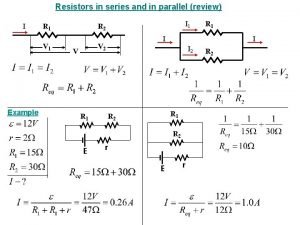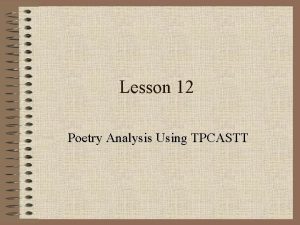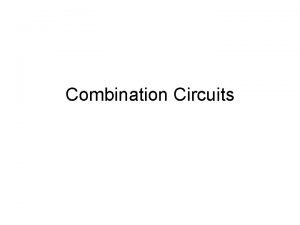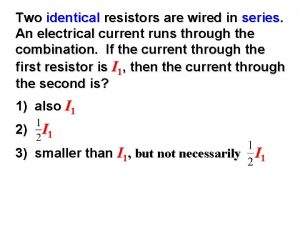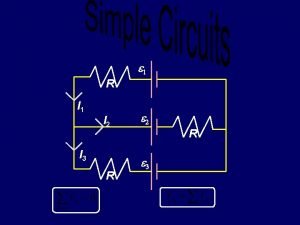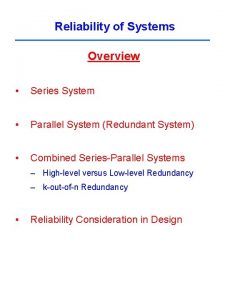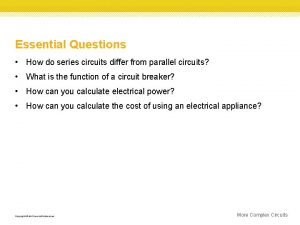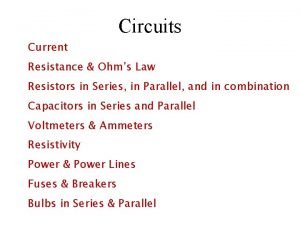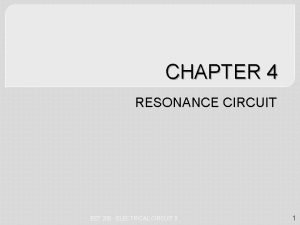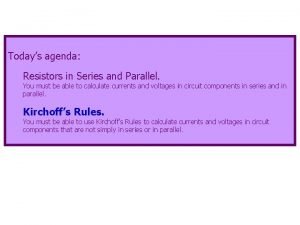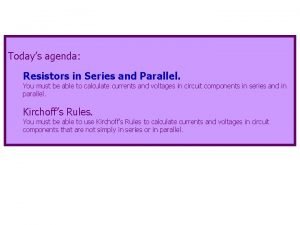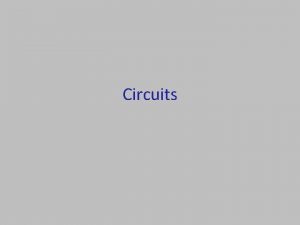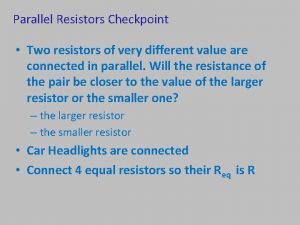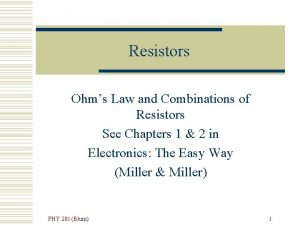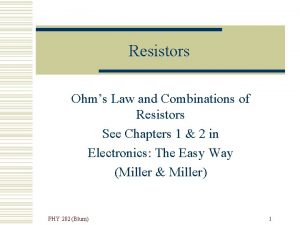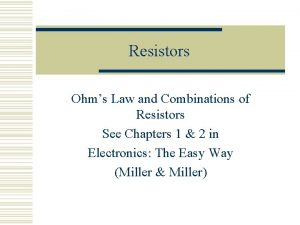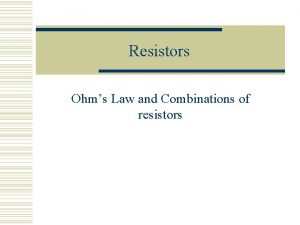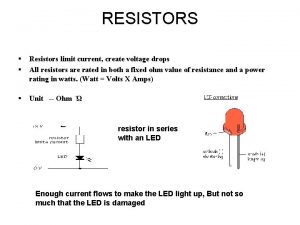Todays agenda Resistors in Series and Parallel You


















- Slides: 18

Today’s agenda: Resistors in Series and Parallel. You must be able to calculate currents and voltages in circuit components in series and in parallel. Kirchoff’s Rules. You must be able to use Kirchoff’s Rules to calculate currents and voltages in circuit components that are not simply in series or in parallel.

Resistances in Circuits There are “two” ways to connect circuit elements. Series: A B Put your finger on the wire at A. If you can move along the wires to B without ever having a choice of which wire to follow, the circuit components are connected in series. Truth in advertising: it is possible to have circuit elements that are connected neither in series nor in parallel. See problem 24. 73 in the 12 th edition of our text for an example with capacitors.

Parallel: A ? ? ? B Put your finger on the wire at A. If in moving along the wires to B you ever have a choice of which wire to follow, the circuit components are connected in parallel. * *Truth in advertising: actually, the circuit components are not connected in series, and may be connected in parallel.

Are these resistors in series or parallel? + - V parallel It matters where you put the source of emf.

Are these resistors in series or parallel? + V series It matters where you put the source of emf.

If resistors “see” the same potential difference, they are in parallel. If resistors “see” the same current, they are in series. V + - + V parallel I V series It’s difficult to come up with a simple one- or two-sentence rule for series/parallel.

Here’s a circuit with three resistors and a battery: I R 1 V 1 I R 2 V 2 I R 3 V 3 + - I V Current flows… …in the steady state, the same current flows through all resistors… …there is a potential difference (voltage drop) across each resistor.

Applying conservation of energy allows us to calculate the equivalent resistance of the series resistors. I am including the derivation in these notes, for the benefit of students who want to look at it. In lecture, I will skip ahead past the derivation.

I R 1 V 1 I R 2 V 2 I R 3 V 3 + - I V An electric charge q is given a potential energy q. V by the battery. As it moves through the circuit, the charge loses potential energy q. V 1 as it passes through R 1, etc. The charge ends up where it started, so the total energy lost must equal the initial potential energy input: q. V = q. V 1 + q. V 2 + q. V 3.

I R 1 V 1 I R 2 I V 2 R 3 V 3 + - I V q. V = q. V 1 + q. V 2 + q. V 3 V = V 1 + V 2 + V 3 V = IR 1 + IR 2 + IR 3 Now imagine replacing the three resistors by a single resistor, having a resistance R such that it draws the same current as the three resistors in series.

I Req V + - I As above: From before: Combining: V V = IReq V = IR 1 + IR 2 + IR 3 IReq = IR 1 + IR 2 + IR 3 Req = R 1 + R 2 + R 3 For resistors in series, the total resistance is the sum of the separate resistances.

We can generalize this to any number of resistors: (resistors in series) a consequence of conservation of energy R 1 R 2 R 3 + - V Note: for resistors in parallel, Req is always greater than any of the Ri.

Here’s another circuit with three resistors and a battery. I 1 R 1 I 2 Current flows… …different currents flows through different resistors… V R 2 V R 3 I 3 V …but the voltage drop across each resistor is the same. + - I V

Applying conservation of charge allows us to calculate the equivalent resistance of the parallel resistors. I am including the derivation in these notes, for the benefit of students who want to look at it. In lecture, I will skip ahead past the derivation.

I 1 In the steady state, the current I “splits” into I 1, I 2, and I 3 at point A. I 1, I 2, and I 3 “recombine” to make a current I at point B. Therefore, the net current flowing out of A and into B is I = I 1 + I 2 + I 3. Because the voltage drop across each resistor is V: R 1 I 2 A V R 2 B V R 3 I 3 V + - I V I

I Now imagine replacing the three resistors by a single resistor, having a resistance R such that it draws the same current as the three resistors in parallel. Req A B V + - From above, I = I 1 + I 2 + I 3, and So that I V I

Dividing both sides by V gives We can generalize this to any number of resistors: (resistors in parallel) a consequence of conservation of charge Note: for resistors in parallel, Req is always less than any of the Ri.

Summary: Series B A same I, V’s add “just like” capacitors NOT “just like” capacitors Parallel A B same V, I’s add “just like” capacitors NOT
 Resistors in series and parallel
Resistors in series and parallel Resistors in series and parallel equations
Resistors in series and parallel equations Todays agenda
Todays agenda Simplifying circuits
Simplifying circuits Identical resistors
Identical resistors A package contains 12 resistors 3 of which are defective
A package contains 12 resistors 3 of which are defective Intrinsic semiconductor
Intrinsic semiconductor Walmart resistors
Walmart resistors Two cylindrical resistors are made from the same material
Two cylindrical resistors are made from the same material Agenda sistemica y agenda institucional
Agenda sistemica y agenda institucional Pros and cons of parallel and series circuits
Pros and cons of parallel and series circuits Series aiding and series opposing
Series aiding and series opposing Parallel systems series
Parallel systems series Differences between series and parallel circuits
Differences between series and parallel circuits Series circuit questions
Series circuit questions Parallel circuit short circuit
Parallel circuit short circuit Difference between resistor and capacitor
Difference between resistor and capacitor Parallel circuit characteristics
Parallel circuit characteristics Parallel vs series
Parallel vs series
